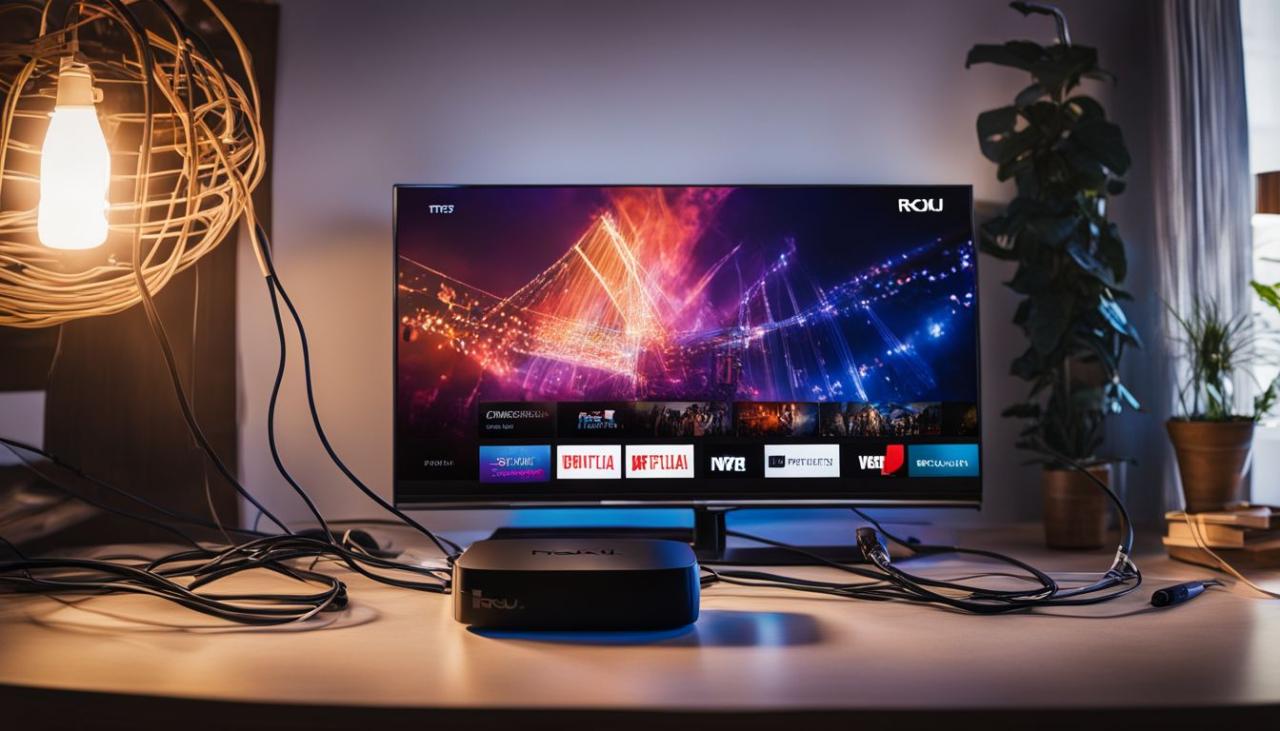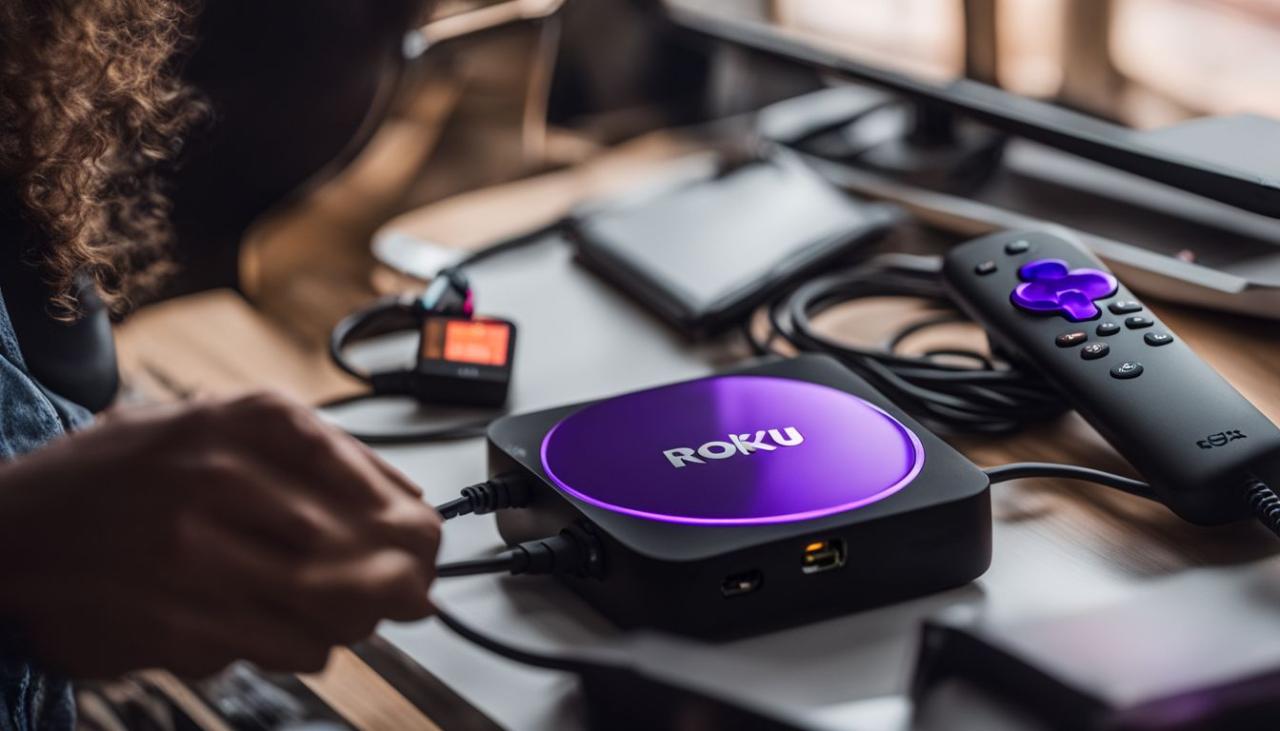Why Does My Roku Keep Restarting? Common Causes and Solutions
February 5, 2024Is your Roku constantly taking unscheduled breaks and restarting itself? This can be caused by various issues, from power hiccups to software glitches. In this post, we’l explore the common culprits behind this pesky problem and provide practical solutions to get your streaming experience back on track.
Keep reading for fixes that could save your movie night!
Key Takeaways
- Your Roku can restart because of overheating, update troubles, app glitches, power issues, or HDMI cable failures.
- To fix restarting problems, keep your Roku cool, check your internet for updates, reinstall buggy apps and channels, and use the right power supply and cables.
- You might need to factory reset your Roku as a last step if other fixes don’t work.
- Prevent future problems by updating software regularly, managing app usage wisely and making sure your device is well ventilated.
- If trouble continues after these steps, get help from official Roku support.
Common Causes of Roku Restarting

Overheating, automatic update issues, glitches in a specific app or channel, power supply issues, and HDMI cable failure are the common causes of Roku restarting. Let’s explore these causes and their solutions in detail.
Overheating
Roku devices can get too hot if they don’t have good airflow. When they are tucked away in entertainment centers or close to other gadgets, the air around them can’t move well. This blocked air makes them warm up.
Dust also adds to this problem by coating internal parts, and this prevents heat from escaping properly. If you touch your Roku and it feels very warm, that’s a sign of overheating.
Keep your Roku device in a cool place with lots of space around it for air to flow. Also, make sure not to use it for too long without breaks, especially on hot days. Your Roku doesn’t have the same cooling parts as bigger electronics do, so it relies on the air moving over its surface to stay cool.
If it gets too hot inside, it might turn off and restart to protect itself from damage caused by high temperatures.
Automatic Update Issues
Your Roku might restart on its own if it’s having trouble updating. Power supply problems can interrupt system updates. Voltage changes or power surges mess up these updates. Outdated software is another reason your device might not update correctly.
It needs regular firmware and software patches to work well.
Make sure your internet connection is stable for updates to install without glitches. A weak Wi-Fi signal strength can cause the Roku to reboot during an update process. Check that the Wi-Fi network isn’t dropping out, especially when new bug fixes or feature improvements are ready for download.
Glitches in a Specific App or Channel
Sometimes a certain app or Roku channel has problems. This can make your Roku restart by itself. If one channel always causes the restart, that could be the source of trouble.
You might need to remove the buggy app and add it again. Make sure all apps stay updated to stop this issue. Check for software updates often in the Roku Channel Store.
Power Supply Issues
Your Roku might restart if it’s not getting the right power. Voltage fluctuations or a weak power adapter can mess it up. Faulty cables or charging through a USB port on your TV could also cause trouble.
If you use a power strip, too many devices at once might overload it.
To fix this, plug your Roku directly into a wall outlet. Try using higher-quality power adapters and cables designed for your device. Make sure the electrical outlet is working well and isn’t causing voltage changes that disrupt your Roku’s operation.
HDMI Cable Failure
An HDMI cable failure can cause your Roku to restart. Ensure your HDMI cables are connected securely and aren’t damaged. Replace any faulty cables with high-quality ones to prevent disruptions in the signal transmission, which can lead to your Roku restarting unexpectedly.
Regularly check your HDMI cables for wear and tear to avoid potential issues with connectivity that may trigger reboots on your Roku device. High-bandwidth digital content protection (HDCP) errors resulting from damaged or low-quality HDMI cables can also prompt frequent restarts, affecting your viewing experience.
Solutions to Fix Roku Restarting

Check your Roku power supply to ensure it’s providing enough power, test your Roku HDMI cables for any issues, and perform a software update to address any glitches causing the restarting.
Check Your Roku Power Supply
- Use a compatible power supply specifically designed for your Roku device to ensure proper functioning.
- Ensure the power supply is plugged into a working wall outlet, and avoid using power banks or USB ports on TVs for power.
- If your device is experiencing restarting issues, try using a different power outlet to rule out electrical problems.
- Check for any loose connections between the power supply and your Roku device, ensuring a secure connection.
- Avoid using damaged or frayed power cords as they can lead to intermittent power supply issues.
- Consider testing the power supply with another compatible Roku device to determine if the issue lies with the power source.
- It’s important to verify that the voltage and current rating of the power supply match the requirements specified by Roku to prevent any potential disruptions in power delivery.
Test Roku HDMI Cables
To troubleshoot Roku restarting issues related to connectivity and signal transmission, testing the HDMI cables is crucial. Ensure that the HDMI cables are securely plugged into both the Roku device and the TV to prevent restarting problems related to loose connections or poor signal transmission.
- Inspect the HDMI cables for any visible damage, fraying, or wear and tear that could affect their performance.
- Test different HDMI cables by swapping them out with known working ones to identify if the issue is related to a faulty cable.
- If possible, use a different HDMI port on your TV to determine if the problem lies with the specific port being used.
- Verify that the HDMI cables are compatible with both your Roku device and your TV model to ensure seamless connectivity.
- Consider using an HDMI extender or repeater if you need to extend the length of your HDMI connection for better signal strength.
Check Your Roku Network Settings
To resolve Roku restarting issues, ensure to check your network settings. Here’s a detailed list of steps to follow:
- Verify Wi-Fi or wired connection stability for uninterrupted streaming.
- Adjust bandwidth-saver settings in “Settings > Network” to avoid excessive data usage.
- Ensure the wireless network is not congested to maintain a stable connection.
- Optimize router settings such as updating firmware and ensuring proper ventilation for optimal performance.
- Consider using an Ethernet cable for a more stable and consistent internet connection.
Perform a Software Update
Perform a software update to keep your Roku device running smoothly and prevent constant rebooting.
- Press the Home button on your Roku remote to navigate to the main screen.
- From the main screen, select “Settings” and then go to “System”.
- Select “System Update” and then click on “Check Now” to see if there are any available updates for your Roku device.
- If an update is available, select “Download” and wait for it to complete.
- Once the download is finished, choose “Install” to update your Roku software.
- After the installation is complete, your Roku will restart itself automatically with the updated software.
Factory Reset Your Roku
To factory reset your Roku:
- Go to the settings menu by navigating to the home screen and selecting “Settings.”
- Scroll down and click on “System.”
- Choose “Advanced system settings.”
- Select “Factory reset” and enter the code provided.
- Confirm the reset, and your Roku device will restart with factory default settings.
Tips to Prevent Roku Restarting

To prevent Roku from restarting, regularly update the software, optimize app usage, and invest in proper ventilation for your device. These tips can help maintain the stability of your Roku system and minimize potential restart issues.
Regularly Update Software
Keep your Roku running smoothly by regularly updating its software. These updates can fix glitches and improve performance, providing essential security patches to safeguard your device.
By staying up to date, you ensure that your Roku operates at its best and reduces the chances of encountering restarting issues.
Optimizing the performance of your Roku is as simple as keeping its software updated. Stay ahead with regular software updates to keep potential glitches at bay and maintain a smooth streaming experience.
Optimize App Usage
To prevent Roku from restarting, optimize app usage by closing unused apps. Ensure to clear cached memory regularly for smooth app performance. Furthermore, adjust streaming quality settings based on your internet speed to avoid interruptions during streaming.
Lastly, update your apps and the Roku system to the latest version for improved stability and functionality.
Investing in proper ventilation can also enhance app usage by preventing overheating issues. Additionally, consider using a different power source, such as a wall outlet or a mobile hotspot, to address any potential power supply issues that may impact app performance.
Invest in Proper Ventilation
Proper ventilation is crucial in preventing Roku from restarting due to overheating issues. By ensuring that your Roku device has sufficient airflow around it, you can significantly reduce the risk of overheating.
Consider placing your Roku on open shelving units or using external cooling fans to improve air circulation and dissipate heat effectively.
Investing in elevated mounts and utilizing room fans can also be beneficial in maintaining optimal temperatures for your Roku device, thus minimizing the likelihood of unexpected restarts.
In conclusion, understanding the common causes and solutions for your Roku restarting issues can help you troubleshoot effectively. Take proactive steps to address power supply problems, overheating concerns, and outdated software.
By implementing these quick fixes and preventive measures, you can enjoy uninterrupted streaming on your Roku device. Share your successful troubleshooting methods in the comments section and seek assistance from official Roku TV support when needed.
Keep exploring the world of entertainment without interruptions!
FAQs
1. Why does my Roku TV or streaming stick keep restarting on its own?
Your Roku might keep restarting because of issues like poor USB power supply, overheating, or the need for firmware updates to fix bugs.
2. Can a bad internet connection make my Roku restart?
Yes, if your Wi-Fi router is causing congestion or if you’re using a mobile hotspot with weak signal strength, it could interrupt your Roku and cause restarts.
3. What should I do if my Roku keeps rebooting?
Firstly check that the USB cable and power adapter are working right. Then cool down your device by improving heat dissipation. Lastly, ensure your system is updated with the latest software patches from Roku support.
4. Will customer support help me if my Roku doesn’t stop restarting?
Absolutely! Reach out to customer support through email, Twitter, Facebook, or their main website for technical assistance.
5. Do other devices connected to my smart TV affect my Roku?
They can! If other gadgets like Chromecast with Google TV or Amazon Fire TVs are taking too much bandwidth on your network; this may cause problems including random restarts of connected devices like your roku
6. Could using an incorrect remote control be why my Ruko is acting up?
It’s unlikely but possible: using remote controls not meant for your Roku such as those made for Alexa voice commands specific smart TV platforms Apple TV 4k may lead to some errors occurring when trying to operate different functions





